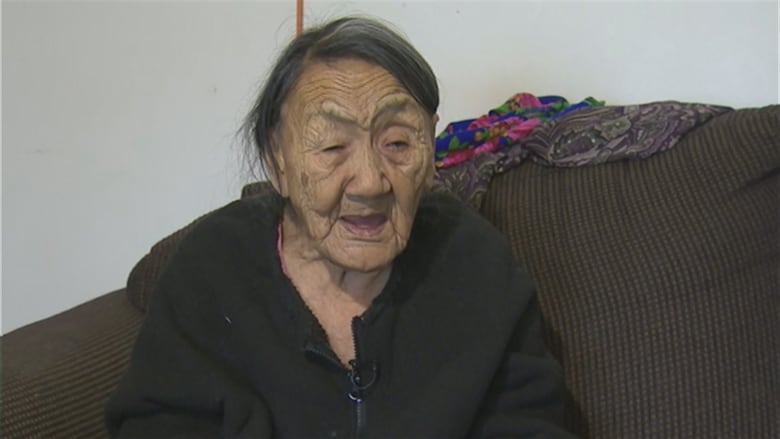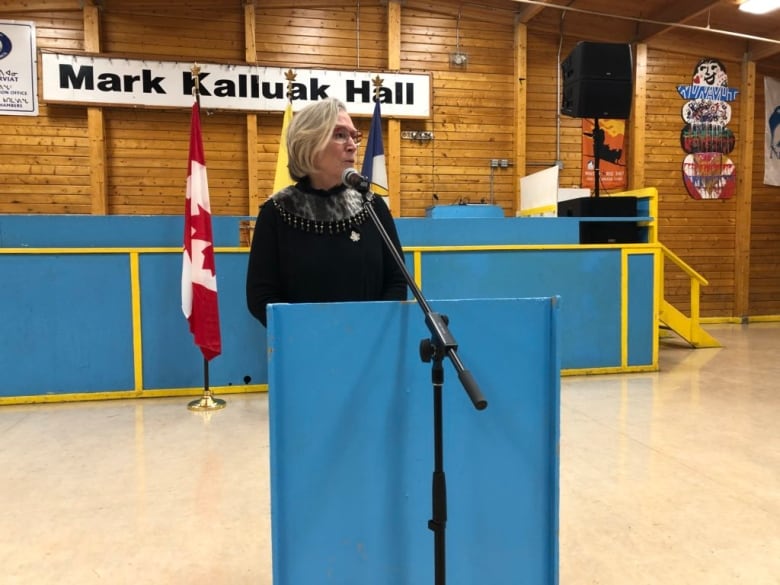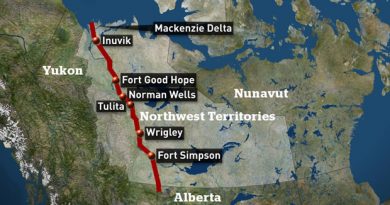Inuk elder in Arctic Canada recalls family’s forced relocation nearly 70 years ago

Twenty one survivors of a brutal forced resettlement by the Canadian government recently gathered in Arviat, Nunavut, for a formal apology.
Mary Anowtalik, 81, was there.
She was a young girl in spring, 1950*, when police arrived with government workers to uproot her and other Ahiarmiut Inuit from their camps at Ennadai Lake in Nunavut’s rugged interior region inland of Hudson Bay.
Anowtalik has kept her story out of the public eye until now.
She said she was waiting all these years for an apology outlining the details of what had been done to her and her family, so no one could call her a liar.
Anowtalik spoke in Inuktitut to CBC journalist Jordan Konek in January.
“Where we were in the first place [Ennadai Lake], we had everything we needed,” Anowtalik said.
“There were no stores, there were no preachers, there were no nurses. There was no hamlet, there was no bylaw. But because of elders and the adults, we lived a good life by their teaching us how to survive.”
The Ahiarmiut lived off the land by hunting and fishing, following a nomadic existence in tune with the seasons.
“At that time, we had everything we ever needed. We had tents in great shape, we had good hunting tools for survival, we had kayaks to go hunting.”
Anowtalik remembers the spring when her family and other Ahiarmiut were drying meat and preparing caribou skins for the summer. A roaring in the sky was followed by the arrival of “qublunaat” — white people.
“We had no clue what was coming to us and that time we had no clue what planes were,” she said. What was coming were police, arriving by plane.

They lined her up with the others in a flat, gravel spot from where Anowtalik says they watched a bulldozer emerge from the distance and crawl toward her family’s camp.
“This thing started plowing all our belongings, everything that we owned,” she said. “I saw our beautiful tent being torn down and then that same bulldozer made a turn and started plowing our fresh dried meat.”
All their belongings were pushed into a pile and covered with gravel “so we couldn’t get into it again.”
She said the Ahiarmiut who were gathered were immediately put onto a plane without being told where they were going. According to a government report, authorities had neglected the “inclusion of an interpreter to explain … why they were being moved.”
Everyone went quietly, except for one.
“My brother was being difficult because he did not want to leave the Ahiarmiut land,” Anowtalik said. “Because he stood up for himself, the RCMP officer started beating him up.”
She said police eventually subdued her brother and loaded him onto the plane.
‘We buried them with what we had’
“After long hours of flying, we came to an area where there was a bunch of trees and then they started going in a loop around the trees and landed in an area around a river.”
The Ahiarmiut, unfamiliar with air travel, were happy to get off the plane and on to firm ground. They were deposited southeast of their homeland near Nueltin Lake, just North of what is now the Manitoba/Nunavut border.
Left with nothing except the clothes on their backs — “we had no tea or food” — some died, she said.
“There was a lot of us that were just in the middle of nowhere outside with no shelter,” she said. “There was absolutely nothing, no mitts, no hats, all we had was our caribou clothing. Luckily it was during spring time so nobody froze to death right away.”

But without shelter in the cold days and nights of early spring, illness was inevitable. “Two old men, two old women and two children all died from coughing and the flu,” Anowtalik said.
The dead were buried on a sandy slope with no traditional burial.
“During my life as a child, [I remember] when family members died we would do proper burials covering them in skin and making sure they’re buried properly — covering their whole bodies in rocks and wood so that they’re protected,” Anowtalik recounted.
“But because where we were had nothing, we buried them with what we had.
“Up to today, burying those people is still in my heart. I don’t think I’ll ever forget them in my life.”
First of several relocations
By summer, the displaced Ahiarmiut were starving, reduced to hunting ptarmigan with rocks.
They may have died on those barren lands were it not for the help of others who travelled in the region. Anowtalik remembers the aid of a tall Cree hunter she calls Piji Jahi. He and his family quickly assembled a collection of food, tools and goods for the Ahiarmiut.
“The whole family of Jahi came to us and they brought everything with them — caribou skin, bear skin, all dried skins ready to use. It was pure joy.”

Jahi and his family lived with the Anowtaliks and fellow Ahiarmiut until they were well.
By the fall, the Ahiarmiut knew they could not survive a winter in the Nueltin Lake area. According to the transcript of the Canadian government’s apology, it took them three months to trek back to Ennadai Lake, walking “more than 100 kilometres through wind, ice and snow.”
In 1957, the Ahiarmiut were forcibly relocated again. This was the second of at least five relocations to come to another barren location several hundred kilometres away.
Anowtalik was finally moved to Arviat in 1958. She received $100,000 as part of the $5-million settlement with the Canadian government over the forced relocations of the Ahiarmiut in the 1950s.
In its apology, the Canadian government acknowledged the relocation of the Ahiarmiut was made “without explanation, without consultation and without consent.”
*Experts say it is difficult to precisely match archival dates with an elder’s recollection of events.
Related stories from around the North:
Canada: Inuit, Sami leading the way in Indigenous self-determination, study says, CBC News
Finland: Finnish gov pulls bill to ratify convention on Indigenous peoples’ rights, Yle News
Sweden: Report sheds light on Swedish minority’s historic mistreatment, Radio Sweden
United States: Governor Walker apologizes for historical trauma at Alaska Federation of Natives convention, Alaska Public Media



